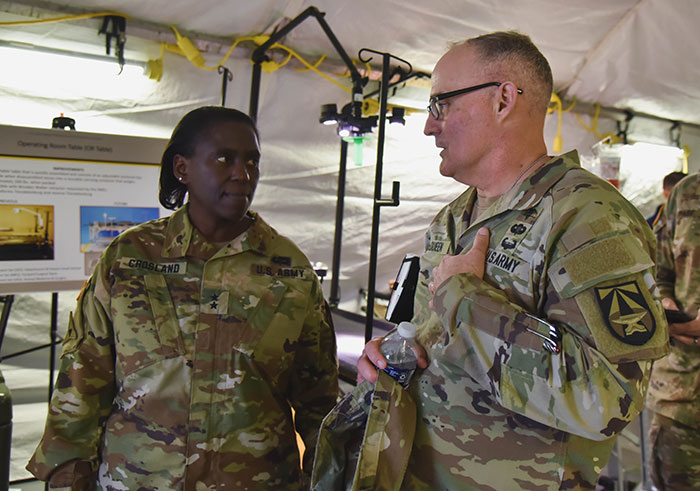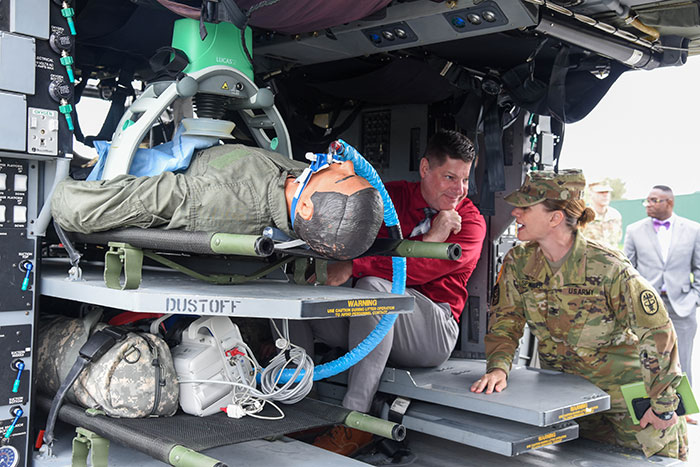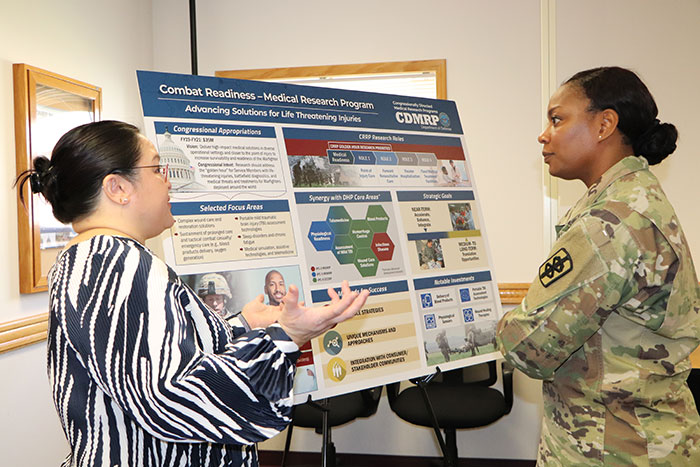Following 'Capability Days', USAMRDC Looks to the Future

The U.S. Army Medical Research and Development Command hosted the first-ever USAMRDC Capability Days event from April 25-28 at Fort Detrick. The event, which was designed to showcase the key roles the command plays in supporting and expanding the scope of military medicine, attracted more than 100 VIP personnel from across the U.S. Department of Defense and beyond for an immersive series of presentations, product demonstrations and discussions with leaders and subject matter experts.
"We created Capability Days to showcase our efforts because it's important for our life-saving work to be better known – and better understood," said Brig. Gen. Tony McQueen, Commanding General of USAMRDC and Fort Detrick, during his keynote address to the attendees. "Our work is critical because Soldiers require unique solutions to the unique threats they face – and so we are always thinking out-of-the-box on their behalf."
USAMRDC Capability Days consisted of a pair of two-day sessions, with each session highlighting the importance of military medical research and acquisition to the health and resiliency of the Warfighter and the Nation. The first day included in-depth presentations from the command's subordinate laboratories and Direct Reporting Units, while the second day featured live, in-person demonstrations of a number medical products supported by USAMRDC.
"Showcasing what you do needs to be paramount," said Col. Kathleen Spangler, director at Fort Belvoir Community Hospital, following a presentation by USAMRDC'S U.S. Army Research Institute of Environmental Medicine. "We do our research to take care of the Warfighter, and then we invest these resources in practical ways; and so what I love about an event like this is that we get to see the connective tissue, the way one effort leads into the other."

The practical application of USAMRDC's efforts was a primary focus of the event, with attendees having the opportunity to not only learn about a variety of current and emerging medical products and devices, but also the acquisition and development path of said materiel and, further, how those efforts factor into larger plans for eventual overmatch during future multi-domain operations.
A key part of this strategy involves the development of a generation of tougher, more portable medical tools and technologies that can withstand the rigors of caring for combat casualties during operations on the future battlefield; situations that will likely take place in dense urban areas far removed from standard lines of support – meaning individual Warfighter units will need to support injured personnel for longer periods of time between attempted evacuations to higher roles of care.
"This is the kind of technology that we need – smaller, more robust, easy to use," said Col. Ross Witters, a surgeon with the V Corps based at Fort Knox, Kentucky, upon viewing the compensatory reserve index tool developed by USAMRDC's U.S. Army Institute of Surgical Research – a tool developed to help to determine when a patient is going into hemorrhagic shock. "It's going to help medics make quick decisions on the battlefield – and by that I mean helping to stabilize casualties and other patients – because they just don't have a lot of time."
Mid-day presentations from USAMRDC's Congressionally Directed Medical Research Programs and the command's Joint Trauma Analysis and Prevention of Injury in Combat unit were also highlighted during the event. Additional presentations took place at USAMRDC's Test Branch and the U.S. Army Medical Materiel Development Activity's Medical Prototype Development Laboratory, and further included such immersive events as a tour of the Telemedicine and Advanced Technology Research Center's cutting-edge Nexus laboratory, which operates as a next-generation research environment designed to explore and analyze the intersection of humans and technology. The event also included a step-by-step reenactment of the proper countermeasures to employ during a chemical-biological casualty event – countermeasures developed and tested at USAMRDC's U.S. Army Medical Research Institute of Infectious Diseases and the U.S. Army Medical Research Institute of Chemical Defense. The event's second day program included demonstrations at a combat field hospital located on the Air Force Medical Readiness Agency grounds on Fort Detrick's Area B; attendees there witnessed a live-action demonstration of a combat casualty care incident, complete with a review of the knowledge and material products used to aid and transport an injured Warfighter from the battlefield to a higher role of care. This segment of the event also included the landing, loading and departure of a Black Hawk helicopter in order to relay the timing and effort required for MEDEVAC operations.

"It's my first time being here at this kind of event, and it's impressive," said Michael Elliott, a project manager at the Defense Health Agency and a recently-retired Army medic. "You have an impression of what it takes to bring these products to fruition, but then you get up-close-and-personal and you can really see the work it takes."
Looking forward, USAMRDC leadership envisions additional, similar events taking place once or twice a year. In the meantime, McQueen says the full value of the 2022 Capability Days will likely only be revealed once the event's attendees return to their respective commands and share their experiences– a strategy that will hopefully spur additional interest from other organizations.
Said McQueen, "We're always moving forward, and we're excited to communicate with the folks that are the end-users of the products we help develop. We're excited to get that feedback from them and excited about moving some of these products along – keeping the momentum going within USAMRDC and the larger Army."














